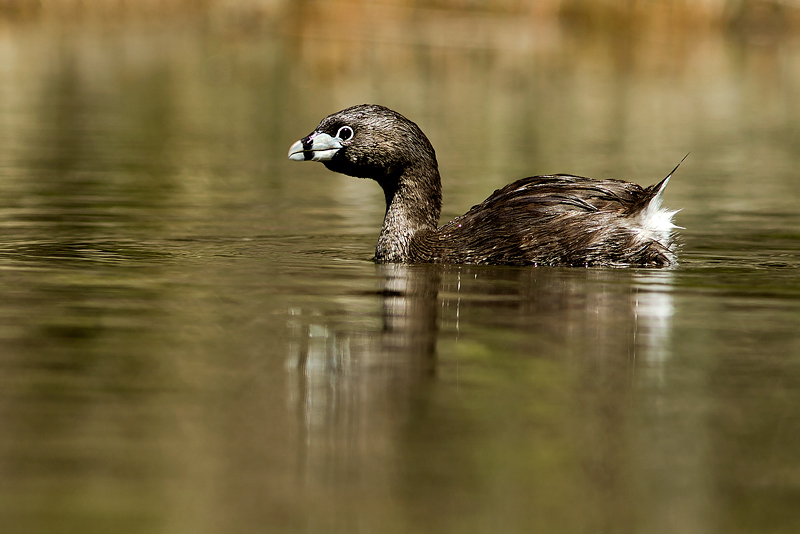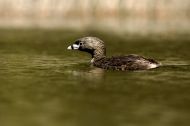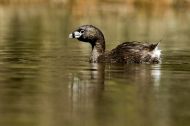Pied-billed Grebe
Macá de Pico Grueso
Podilymbus podiceps
Length: 320 mm. Sexes alike. Bill whitish grey encircled by a broad transversal black band in the middle; iris brown, whitish eyelid; crown dark brown; sides of head greyish brown; chin and throat pitch black; sides of neck ash brown, lower neck ochraceous brown; upper neck blackish brown. Above and tail dark brown; wing coverts dark brown; primaries and secondaries brownish; axillaries white; chest and belly silky silvery white; flanks, same, with profuse dark brown to blackish brown spotting; crissum, whitish. Legs, greenish slate.
Juveniles: duskier; plumage and browner; sides of head and neck cinnamon brown; longitudinal brown and whitish banding on face and neck; breast and belly, uniform white. Adult nonbreeding plumage: lacks black banding on bill; chin and throat, white; neck, brownish cinnamon; and colouring is somewhat browner overall. Readily identified for its short and thick bill, dull plumage and lack of ornamental crest. Habitat and behaviour: usually found solitary, in pairs or in family groups during the breeding season. The Pied-billed Grebe is the most wary and skittish of all grebes. Primarily found in ponds and lakes with abundant aquatic vegetation, also found in slow-flowing rivers and streams. It feeds on fish, insects, larvae, crustaceans, molluscs, and other small animals, and eats large quantities of feathers, mostly its own. In alarm, it sinks surreptitiously in the water and disappears from view; when it reappears it does so only showing its bill and sometimes part of head, successfully hiding from enemies.
Nests are big floating structures anchored to nearby plants, usually built in shallow waters with decaying water plants and hidden among the surrounding vegetation; female lays 3-8 bluish white eggs that in a few days turn brownish due to the decomposing plants that form the nest. Both parents take turns to incubate and take care of the chicks. These are very precocious, swimming and diving almost immediately after hatching. Both parents carry them on their backs. Although usually silent, during the breeding season they are frequently heard over great distances as they utter a loud, mighty and slightly doleful call that is repeated several times; also, nasal contact calls and clucks. Range: Patagonia, from Neuquén and Río Negro to Santa Cruz.
Illustrated Handbook of the Birds of Patagonia
Kindless: Kovacs Family
|










